Captain Nemo
Captain Nemo (/ˈniːmoʊ/, later identified as an East Indian, Prince Dakkar), is a fictional character created by the French novelist Jules Verne (1828–1905). Nemo appears in two of Verne's science-fiction classics, Twenty Thousand Leagues Under the Seas (1870) and The Mysterious Island (1875). He also makes a cameo appearance in a play on which Verne may have collaborated, Journey Through the Impossible (1882).
| Captain Nemo | |
|---|---|
| Voyages extraordinaires character | |
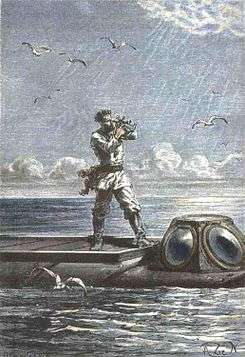 Captain Nemo taking noon observations. | |
| First appearance | Twenty Thousand Leagues Under the Seas (1870) |
| Last appearance | Journey Through the Impossible (1882) |
| Created by | Jules Verne |
| In-universe information | |
| Alias | Prince Dakkar |
| Gender | Male |
| Title | Captain; Prince |
Nemo is a mysterious figure. Though originally of unknown nationality, he's later described as the son of an East Indian raja. A scientific visionary, he roams the depths of the seas in his submarine, the Nautilus, which was assembled from parts manufactured in several different countries, then shipped to a cover address. The captain is consumed by a hunger for vengeance and hatred of imperialism; the British Empire is ultimately revealed as his main antagonist.
Nemo has appeared in various film adaptations of Verne's novels, where he has been portrayed by such celebrated actors as James Mason, Herbert Lom, Naseeruddin Shah, Michael Caine. He has also been appropriated by other authors for their own novels, including Alan Moore's The League of Extraordinary Gentlemen, Philip José Farmer's The Other Log of Phileas Fogg, Kevin J. Anderson's Captain Nemo: The Fantastic History of a Dark Genius, Thomas F. Monteleone's The Secret Sea and Howard Rodman's The Great Eastern.
Etymology
Nemo is Latin for "no one" or "nobody".
Moreover Nemo is itself the Latin translation of the Ancient Greek Outis ("Nobody"), the pseudonym adopted by Odysseus, in Greek mythology—a ruse employed to outwit the Cyclops Polyphemus. This appears to be the intended meaning, since in The Mysterious Island, when Cyrus Smith addresses him as Captain Nemo, the latter replies, "I have no name!"
Fictional character biography

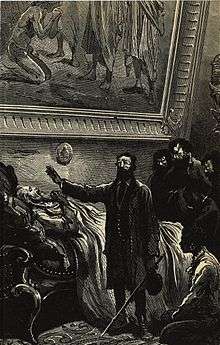
Chief among the few details of Nemo's history given in Twenty Thousand Leagues Under the Seas are his hatred of imperialism and his grief over the loss of his loved ones in years past.
In The Mysterious Island, Captain Nemo identifies himself as Prince Dakkar, son of the Hindu raja of Bundelkhand, and a descendant of the Muslim Sultan Fateh Ali Khan Tipu of the Kingdom of Mysore, famous for the Anglo-Mysore Wars (1767–1799) and Mysorean rocket technology. After the Indian Rebellion of 1857, in which Dakkar lost both his family and his kingdom, the prince devoted himself to scientific research, ultimately building the Nautilus and cruising the seven seas with a crew of devoted followers.[1] They gather bullion from various shipwrecks in the ocean, most notably from the hulks of the Spanish treasure fleet sunk during the Battle of Vigo Bay. Nemo claims to have no interest in terrestrial affairs but occasionally intervenes to aid people in distress, e.g., by giving salvaged treasure to participants in the Cretan Revolt (1866–1869) against the island's Turkish rulers ... by saving (both physically and financially) a Ceylonese or Tamil pearl diver from a shark attack ... by rescuing the castaways in Twenty Thousand Leagues Under the Seas ... and by covertly protecting another set of castaways in The Mysterious Island.
Like many actual East Indian princes of the era, Nemo received a Western education, during which, as he states, he spent his youth touring and studying throughout Europe. In his first meeting with Professor Aronnax and his companions, the three castaways speak to him in French, English, Latin, and German; Nemo later reveals that he is fluent in all of these tongues. Aronnax praises the captain's French, noting that he "expressed himself with perfect ease and without any accent." Relying on his intuition and knowledge of ethnology, the professor concludes that "there's southern blood" in him but can't determine the captain's exact origin. The Nautilus's library, lounge, and art collections reveal that Nemo is intimately acquainted with European culture, also that he's an accomplished performer on the organ.
Nemo dies of unspecified natural causes on board the Nautilus, docked permanently inside Dakkar Grotto on Lincoln Island in the South Pacific. Cyrus Smith, leader of the castaways whom Nemo protected, administered the last rites, then submerged the Nautilus in the grotto's waters.
Character

Nemo's characteristics are largely presented through the observations of Professor Pierre Aronnax, narrator of Twenty Thousand Leagues Under the Seas. At their first meeting, the professor remarks: "Whether this individual was thirty-five or fifty years of age, I couldn't tell." He goes on to describe Nemo as a tall, self-contained man with a straight nose, broad brow, and wide-set eyes—"certainly the most wonderful physical specimen I'd ever met up with." In The Mysterious Island, the captain is in his late sixties and sports a long white beard.
He avoids dry land, except for desert islands and uninhabited regions such as Antarctica. In keeping with his contempt for surface civilization, he uses few commodities that aren't marine in origin, be they food, clothing, or even tobacco. As for his political views, he reveals an intense hatred of oppression, which he associates with the world's imperialistic nations. He therefore identifies himself with the Earth's oppressed, whether Ceylonese pearl divers, Cretans rising against the Turks, or even right whales attacked by sperm whales. When Professor Aronnax suggests that Nemo violates maritime and international law by sinking warships, Nemo responds that he does so in self-defense when attacked. What's more, he insists that terrestrial laws no longer apply to him, exclaiming in one scene:
The sea doesn't belong to tyrants. On its surface they can still stake their evil claims, battle each other, devour each other, haul every earthly horror. But thirty feet below sea level, their power ceases, their influence fades, their domination vanishes! Ah, sir, live! Live in the heart of the seas! Here alone do I find independence! Here I recognize no superiors! Here I'm free![2]

Nemo is devoted to his crew and grieves deeply when members are killed after a mysterious collision with a surface vessel or during a giant squid attack in the Caribbean Sea. He's equally compassionate in his treatment of the castaways in The Mysterious Island, also retaining a deep attachment to his deceased wife and children. Despite these tragic losses, he rarely expresses his anger. Moreover he's a man of immense courage, taking the lead in every emergency, from fighting sharks and squid to releasing the Nautilus from Antarctic ice—an ordeal that entailed reduced oxygen stores and consecutive eight-hour shifts. Aronnax also credits him with discovering Atlantis.
An innovative engineer, Nemo both designed and manufactured the Nautilus, including her electric propulsion units and navigational systems. Utilizing them with extraordinary skill, he negotiated some of the ocean's most difficult underwater passages, such as those beneath the Antarctic ice barrier, as well as a fictitious tunnel under the Isthmus of Suez.
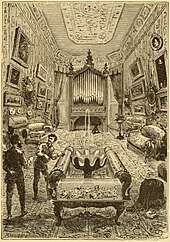
He has an exhaustive knowledge of marine biology, and it's his respect for Professor Aronnax's preeminence in the field that led to his befriending the professor once the latter was cast aboard the Nautilus. Further, Nemo seems to have been a genuine polyglot, able to read all the books in the Nautilus's vast library, regardless of their language.
The captain has an exquisite taste in the fine arts, possessing many masterpieces of both painting and sculpture, from old masters to moderns. They're housed in the main lounge of the Nautilus along with Nemo's collection of pearls, corals, seashells, and other marine items, all gathered with his own hands. "No museum in Europe," Aronnax tells the captain,"has such a collection of exhibits." Yet, despite the opulence visible throughout the Nautilus, Nemo's stateroom was furnished with little more than a bed, a worktable, and the navigational instruments essential to the Nautilus. Even so, Captain Nemo claims to be extremely wealthy, boasting that "without the slightest trouble I could pay off the two-billion dollar French national debt!"
Nemo later tells Aronnax that he will enclose his scientific findings and autobiography in a small unsinkable container: "The last one of us left on the Nautilus will throw that container into the sea, and it will drift wherever the waves take it."
Subsequently, however, a rather different container does wash ashore in The Mysterious Island, bearing tools, firearms, navigational instruments, an atlas, books, blank paper, and even clothing. They're found in a crate lashed to empty barrels, its contents sealed in a waterproof zinc envelope and showing careful preparation and packing. Throughout the same book, Nemo repeatedly acts in this providential way, as when the sailor Pencroff pines for tobacco, then the young naturalist Harbert actually identifies some among the island's plant life.
Emblem
Captain Nemo's emblem, as reproduced on the flag he raised when claiming the South Pole, is a large golden N on a black field. The motto of the Nautilus was Mobilis in mobili, a Latin phrase which Aronnax translates as "Moving within a moving element". It also has been rendered as "Moving within motion" and "Changing with change".
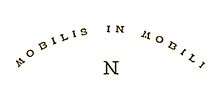
Origin
In early drafts of Twenty Thousand Leagues Under the Seas, Nemo appears as a Polish noble, a member of the szlachta bent on avenging the murder of his family during Russia's violent suppression of the January Uprising. However Verne's editor Pierre-Jules Hetzel feared that the book not only would offend the Russian Empire, a major French ally, but would also be banned from that country's bookstores. Accordingly Hetzel insisted that Verne revise the novel to conceal Nemo's background and political motivations.[3][4]
Chronological discrepancies
Twenty Thousand Leagues Under the Seas was first published in 1870 and reports the activities of the Nautilus over the years 1866 to 1868. The Mysterious Island was published in 1875 but is set in the years after the close of the American Civil War, i.e, 1865 to 1869. Described as an elderly man in his late sixties, Captain Nemo claims in its pages to have conducted his undersea travels some sixteen years earlier than the dates given in the prior novel.
It's true that the first French hardcover issue of Twenty Thousand Leagues Under the Seas (an octavo edition published in 1871 by Pierre-Jules Hetzel) contains minor errors that may have been perpetrated by its printers or even by Hetzel himself—who, at times, seems to have made edits without querying Verne. However the chronological discrepancies between this book and The Mysterious Island appear to have been present since its publication. They may have arisen from Hetzel's insistence that Verne drastically revise his original concept for the latter novel, in which, some scholars speculate, he hadn't initially planned to include Captain Nemo at all.
Portrayals
In most subsequent media adaptations of 20,000 Leagues and Mysterious Island, Captain Nemo is depicted as a European, in accordance with the earlier of the two novels. Actors who have played him include:
- Allen Holubar in 20,000 Leagues Under the Sea (1916)
- Lionel Barrymore (as Count Andre Dakkar) in The Mysterious Island (1929)
- Leonard Penn in the Columbia film serial Mysterious Island (1951)
- Thomas Mitchell in the TV series Tales of Tomorrow (1952)
- James Mason in the Walt Disney film 20,000 Leagues Under the Sea (1954)
- Herbert Lom in Mysterious Island (1961)
- Robert Ryan in Captain Nemo and the Underwater City (1969)
- Omar Sharif in La isla misteriosa y el capitán Nemo (1973)
- Len Carlson in the animated series The Undersea Adventures of Captain Nemo (1975)
- Vladislav Dvorzhetsky in the Soviet television miniseries Captain Nemo (1975)
- José Ferrer in the TV movie and short-lived TV series The Return of Captain Nemo (1978)
- Akio Otsuka in the anime series Nadia: The Secret of Blue Water (1990–1991)
- John Bach in the TV series Mysterious Island (1995)
- Michael Caine in the ABC-TV miniseries 20,000 Leagues Under the Sea (1997)
- Ben Cross in the NBC TV movie 20,000 Leagues Under the Sea (1997)
- Naseeruddin Shah in the film The League of Extraordinary Gentlemen (2003)
- Patrick Stewart in the TV movie Mysterious Island (2005)
- Sean Lawlor in the film 30,000 Leagues Under the Sea (2007)
- W. Morgan Sheppard in the film Mysterious Island (2012)
- Faran Tahir in the TV series Once Upon a Time (2016–2017)
In culture
Nemo is the official file manager for the Cinnamon desktop environment; the name plays off of the Nautilus file manager from which it was forked.[5] A Polish singer - Bogdan Gajkowski - popular especially during the 1980s, started recording song under the name "Kapitan Nemo" the Polish name of Captain Nemo.
The Japanese otome visual novel, Code: Realize- Guardian of Rebirth, features a scientist named Nemo. Nemo created an airship named the Nautilus within the game. He considers the engineer Impey Barbicane, a reference to another Jules Verne novel, his ultimate scientific rival.
Images
 A working drawing of the Nautilus.
A working drawing of the Nautilus.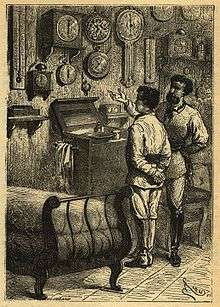 Captain Nemo's stateroom.
Captain Nemo's stateroom. The Nautilus's library.
The Nautilus's library. The Nautilus's engine room.
The Nautilus's engine room. Diver appearing off Crete.
Diver appearing off Crete.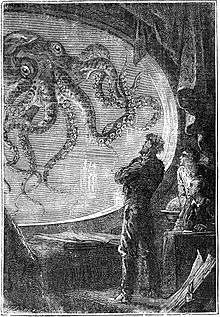 Menaced by a giant squid in the Bahamas.
Menaced by a giant squid in the Bahamas.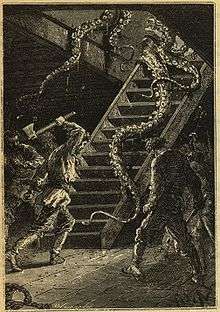 Fending off a squid attack.
Fending off a squid attack. Underwater wreckage in the Mediterranean.
Underwater wreckage in the Mediterranean.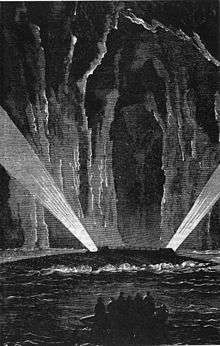 The Nautilus in Dakkar Grotto, as described in The Mysterious Island
The Nautilus in Dakkar Grotto, as described in The Mysterious Island
References
- Rovin, Jeff (1987). The Encyclopedia of Supervillains. New York: Facts on File. pp. 51–52. ISBN 0-8160-1356-X.
- Verne, Jules (2010) [1870]. 20,000 Leagues Under the Seas. Translated by Frederick Paul Walter. ISBN 978-1-4384-3238-0 – via Wikisource.
- Perschon, Mike (February 1, 2010). "Finding Nemo: Verne's Antihero as Original Steampunk" (PDF). Verniana: Jules Verne Studies. 2: 181–182.
- Nevins, Jess (2005). The Encyclopedia of Fantastic Victoriana. Austin, Texas: Monkeybrain Books. p. 128. ISBN 978-1-93226-515-6.
- Lefebvre, Clement (September 4, 2012). "Introducing Nemo". Archived from the original on June 22, 2015. Retrieved May 4, 2014.
External links
- Captain Nemo on IMDb
- The Mysterious Island: The Secret of the Island: Chapter XVI. A summary of his life.
- Literary analysis of the novels of Jules Verne (In French)
- The origin of Captain Nemo: at Captnemo's Home
- Published in 2017 a new, illustrated book of Jules Verne's classic sci-fi novel by UK artist G.M. Burley (limited runs)
